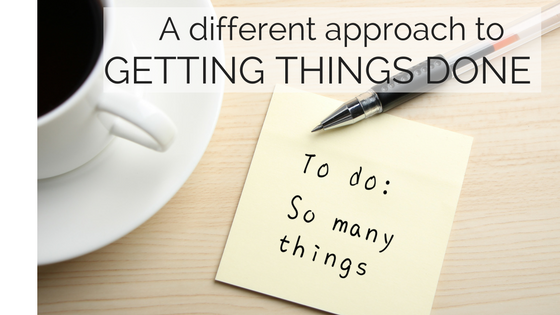
How Does an Entrepreneur With (or Without) ADHD Stay Motivated?
This was a question I was recently asked on Quora, but it’s one that comes up almost daily during coaching sessions with my clients. So, here’s an enhanced version of my response. While geared towards entrepreneurs (with or without ADHD), it also applies to anyone who wants to get things done, but occasionally loses momentum.
The reality is that you won’t always feel motivated, even if you love what you do. You’ll feel frustration, anxiety, confusion and boredom (and those are the easy ones!). Even when motivated, you may feel stuck and not able to activate (an executive function of initiating action that doesn’t always correlate with motivation, or wanting to do something).
So, start from this reality and accept you will have challenges staying motivated (even without ADHD, being an entrepreneur is difficult, but having it does make things tougher). Realize you do have solutions, although it may take some effort to discover them! (And not just for getting motivated, but for most entrepreneurial stressors.)
Here are some motivating Motivation tips:
Prepare Strategies & Workarounds in Advance. You can then pull them out of your handy ‘SOS: I Need Help’ toolbox as needed. Use a physical box with index cards, a file on your computer or phone, an actual file folder, or a paper or electronic notebook. Sometimes, we need these pre-packaged options to choose from, as ‘doing what comes naturally’ just doesn’t cut it, and it’s easy to forget ways that we motivated ourselves in the past – even ones that worked. Memory is not reliable, especially when feeling overwhelmed. So, when something (a strategy, tool, system, book, podcast, motivational quote, mindset, etc.) works or sounds inspiring, make a note of it and put it in your toolbox. You may need it in the future, since the best time to think about what gets you motivated, or what will inspire you to begin working, isn’t when you are feeling down, although sometimes you’ll be able to use an uncomfortable situation as a springboard to inspire your innovative mind to create success strategies on the fly. When you begin thinking like a detective, you will discover solutions that had eluded you when you were caught up in a victim (“nothing works, I’ve had it”) mentality. Go for it!
Allow for ‘Down Time.’ Realize that being an entrepreneur is time and energy consuming to the extreme, which drains motivation. Build in white space; free time to recharge your batteries (even at the expense of not getting everything done as scheduled). Make time to reset your brain by being outside, through exercise, mindfulness or meditation, journaling, reading, listening to or playing music, doing hobbies like artwork or gardening, playing with pets or spending time with friends and family you like (note the caveat there!), napping, volunteering, etc. You don’t have time, you say. True, but if you don’t make time, you’re working with the law of diminishing returns. As the airlines say, put the oxygen mask on yourself first. Stepping away often gives new perspectives and greater energy (how many ideas do you have in the shower, or when taking a walk?).
Edit Your ‘DO’ Lists. Of those things on your ‘Do’ list, what can you Modify? Delay? Delete? Delegate? Outsource? Not everything is urgent, and even if it is, there’s usually a way to change other’s expectations so you can still deliver, so long as you are clear and considerate in your communications. Or change your expectations about your deliverable, so you’ll want to get it done. Watch out for paralysis by analysis, overthinking or over-researching. Perfection is the enemy of productivity and motivation. Create a ‘Do NOT Do’ list so you don’t get sidetracked. Create a place to jot down non-immediate ideas or concepts (a Parking Lot for your thoughts) so you don’t lose them, but don’t get distracted by those brighter, shinier objects.
Periodically, Prune & Review Your Business. Give thought as to what currently brings you the greatest satisfaction or the most profit. Technology that might have worked can become a source of frustration. Marketing that seemed important might not be paying for itself. Services that were ideal at one point might have become time, energy and money drainers. Letting go of what doesn’t work is freeing and can re-energize your engagement in the business, especially when it makes room for stuff that excites you.
Energize Your Systems. Expedite what you can so you spend less time on routine (boring) tasks, whether it’s better organization for greater efficiency, setting up templates for repetitive tasks, using productivity-related software or creating systems to improve ongoing processes. Let go of the guilt or need to do it all and get help where you struggle. If you are spending an inordinate amount of time doing tasks that can be delegated or outsourced, hire someone so you can focus on your strengths. You’ll make less profit initially, but you’ll develop a much more powerful business with less likelihood of burnout. Even on a personal level, many relationships improve when a house cleaner or professional organizer is hired. Sometimes we just need some support and compassionate accountability. Especially if you are a solopreneur. Join a mastermind group, find a business accountability partner who will also benefit, or hire a supportive coach.
Planning Time Saves Doing Time. When there’s so much to do we want to just jump in and get going – until we’re overwhelmed and lose motivation. Build in time for long-term, weekly and daily planning. You’ll save that time and more because your ‘doing time’ will be more effective and targeted towards success.
Avoid Overwhelm. While some pressure or stress is helpful for pushing us towards action, too much will trigger the ‘Fight-Flight-or-Freeze’ response. It’s brain-based and automatic. So, know your triggers. Often, this happens when we confuse a Project with a Task. You can’t DO a project, you can only work on a specific task. The more specific, the easier it is to begin it, whereas when we think of doing a project, all the elements lump together and feel overwhelming, triggering brain-based avoidance (this is NOT a moral/laziness issue!).
Keep Your End-Goal in Mind. It’s easy to get so caught up in the daily pressures that we lose track of why we became entrepreneurs. What does your work mean to you, to others, to the world? Why did you start what you are doing? What do you hope to achieve? Maybe you are going through a rough patch. Maybe you want to rethink some of the details. But you’re in it for a reason. Keep a reminder of that initial vision where you’ll see it. Be careful not to confuse current outcome with long-term vision. It can be demotivating when earnings, customer base, product development, etc. trails your expectations (desired outcome). Re-focus on the inspiration of your vision (what you want to achieve and why) to re-energize, so you are motivated to take those steps that will make it happen.
What works for you? Share your success strategies below.
For more ideas about Productivity, Time Optimization, Organization, ADD/ADHD, Executive Function, Communications, Workplace Issues, Relationships, Self-Care and tips for living a life you love, see my other blog posts at www.SusanLasky.com/Blog




















